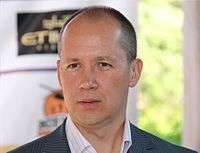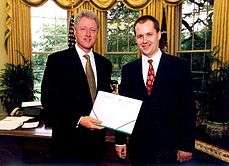Valery Tsepkalo
| Dr. Valery Tsepkalo | |
|---|---|
 | |
| Native name | Цепкало Валерий Вильямович |
| Born |
22.02.1965 Grodno, Belarus |
| Nationality |
|
| Education | Moscow State Institute of International Relations |
| Occupation | Diplomat |
Valery Tsepkalo (Russian: Валерий Цепкало; born 22 February 1965) is a Belarusian diplomat and executive, founder of Belarus Hi-Tech Park. From 1997 to 2002 he served as Ambassador to the United States of America and to the United Mexican States, and from 2005 to 2017 he headed Belarus Hi-Tech Park which became the largest IT cluster in Central and Eastern Europe over that period. He also served as a governmental expert to the UN Secretary General in the field of information and communication technologies. Valery Tsepkalo has a Doctor degree in International Law, as well as a rank of Ambassador extraordinary and plenipotentiary.
Biography
Valery Tsepkalo was born in Grodno on February 22, 1965 to a family of chemical engineers. He graduated from Grodno secondary school No.14 with advanced program in English. In 1982 he entered the Belarusian Technological Institute (currently the Belarusian National Technical University) in Minsk where he studied till 1984. In 1984—1986 he underwent compulsory military training in the USSR Strategic Missile Forces. After that, he studied at the Moscow State Institute of International Relations of the USSR Ministry of Foreign Affairs and graduated with honors in 1991. He pursued a postgraduate program there, graduated with honors as well, lectured, and got his PhD degree in International Law.

He started his diplomatic career in 1991 in the USSR Embassy in Finland. After the dissolution of the Soviet Union he decided to return to Minsk, and in 1992 he took a position in the Ministry of Foreign Affairs of the Republic of Belarus. In 1993—1994 he served as foreign policy adviser to the Chairman of the Parliament of Belarus. Later he became an adviser to the Executive Secretary of the Commonwealth of Independent States.[1]
In 1994 he was appointed First Deputy Minister of Foreign Affairs of the Republic of Belarus.
From 1997 to 2002 he served as Ambassador Extraordinary and Plenipotentiary of the Republic of Belarus to the United States of America and the United Mexican States (concurrently).
After finishing the diplomatic career, he was appointed Assistant to the President of Belarus (on science and technologies).[2] In 2004 he initiated the establishment of the Hi-Tech Park.
Heading Belarus Hi-Tech Park
When serving as an ambassador to the United States and lecturing in the Silicon Valley, Valery Tsepkalo came up with the idea to create a similar powerhouse in Belarus. One of the most urgent challenges for the former Soviet Union countries at that time was the so-called brain drain when, having no prospects in their homelands, the best professionals left for the more prosperous western countries. Establishing of an IT cluster seemed to be promising in keeping those people home which could become a trigger for the evolvement of a new industry in Belarus — computer software development.
Back in Minsk after finishing his diplomatic career, Valery Tsepkalo started probing for the establishment of Belarus Hi-Tech Park (HTP). The priority then was given to agriculture and industry so at first the idea of creating a hi-tech park lacked appreciation. Belarus' exports of IT services was about $14 million, and there hardly was anyone to take the information technology industry seriously. Most government officials did not believe that it could become possible in Belarus.
Eventually they accepted the idea of HTP: 'Okay, since this toy does not require capital infusion, let it be. It will not be of benefit but won't harm either.'[3] Belarus Hi-Tech Park was established in 2005 with an ambitious goal to increase exports to $300 million in 10 years.
As a result, according to numerous researches[4][5] and many experts,[6] HTP headed by Valery Tsepkalo managed to propel Belarus' IT industry to the level of world's leaders.[7][8] EPAM, IBA, Exadel, Itransition, and other Belarusian companies are now among the world's leading IT services providers, while products developed in Belarus, such as Viber, World of Tanks, and MSQRD changed the country's image on the global market rapidly and enabled HTP to prove its status as one of the largest IT clusters in Central and Eastern Europe.[9][10] The success of HTP was reported by the leading media, including Bloomberg Business Week, Wall Street Journal, Financial Times, Euronews, NTV, etc.
Office buildings, R&D and social infrastructure facilities were constructed on the 55-hectare territory allocated for the Hi-Tech Park. The floor area of the office buildings on the territory of the Park is over 70,000 square meters, including an administrative complex, a business incubator, and offices of EPAM and IBA which allowed creating over 2,000 new jobs. In addition, a sports and recreation complex of 2,350 square meters and a data center for business process automation meeting international standards of reliability and performance. Also, nine apartment buildings, a kindergarten, and an elementary school were build on the territory of the Park for its employees.
Over the 10-year history of the Park, the number of HTP residents has increased 41 times (from 4 companies in 2006 to 165 companies in 2016), computer software and services exports have evolved 39 times (from $21 million in 2006 to $820.6 million in 2016), the number of HTP employees has raised 10.9 times (from 2,506 in 2006 to 27,342 in 2016), and Belarus has improved its ICT Development ranking by 41 positions, according to the International Telecommunication Union.[11][12] Gartner, a world's leading information technology research and advisory company, named Belarus among the top-10 most attractive locations for captive or outsourced IT and business process services in the EMEA (Europe, Middle East, Africa) region; Belarus is also second in the world (after Israel) by the share of information technology in the country’s GDP.[13][14]
Research and publications
- 80 articles on religion, world economy, and foreign policy.
- 20 articles on e-government, information technology, and intellectual property.
- Publications in Foreign Affairs, Journal of Congress, Washington Post, Frankfurter Allgemeine, and Horizons.
- By the Road of Dragon States book on economic development of new industrialized nations of South-East Asia.
- Man Everlasting book on the mystery of death and resurrection.
- Hi-Tech Park: 10 Years of Development book on Belarus HTP success story.
- Numerous blogs about ways of Belarus’ development.
Other occupations
- Member of the Strategic Council of the United Nations Global Alliance for ICT and Development.
- Government expert to the UN Secretary General in the field of information and communication technologies.
- Expert to the UN Secretary General in the field of information security.
References
- ↑ Background (in Russian)
- ↑ Valery Tsepkalo
- ↑ Цепкало рассказал, как продвигал налоговые льготы для ПВТ
- ↑ Деятельность парка высоких технологий: трехкратное увеличение экспорта ИТ-услуг и что будет, если парк закрыть
- ↑ Пять главных достижений Цепкало на посту главы ПВТ
- ↑ Belarus tech dream is a walk in the park
- ↑ Belarus on the leading IT radars
- ↑ Belarusian Tech Companies Lead a Global Technological Advance in Outsourcing and Product Development
- ↑ World of Tanks shows Belarus potential beyond Soviet-era farms
- ↑ Belarus 2.0: tech's bright spot in a struggling economy
- ↑ 10 лет ПВТ: впечатляющие цифры о "белорусской Кремниевой долине"
- ↑ HTP Announced 2016 Results"
- ↑ Evaluate Offshore/Nearshore Countries for Outsourcing, Shared Services and Captives in EMEA, 2016
- ↑ Building an Inclusive ICT Innovation Ecosystem
External links
- Tsepkalo — Valery Tsepkalo at Livejournal.